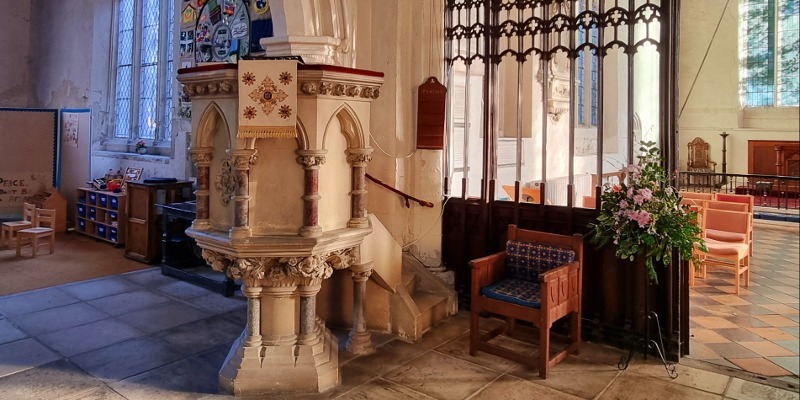
History of St. Mary's Church
St. Mary the Virgin has stood in the heart of the village for almost 800 years. Construction started in the 13th century and continued throughout the 14th,15th and 16th centuries. There is also evidence of an even earlier church on the site. It is a grade 1 listed building of great historic and architectural importance. It was built on prominent ground so that it can be seen from all directions. It is a symbol of belief and trust that has endured through the ages.
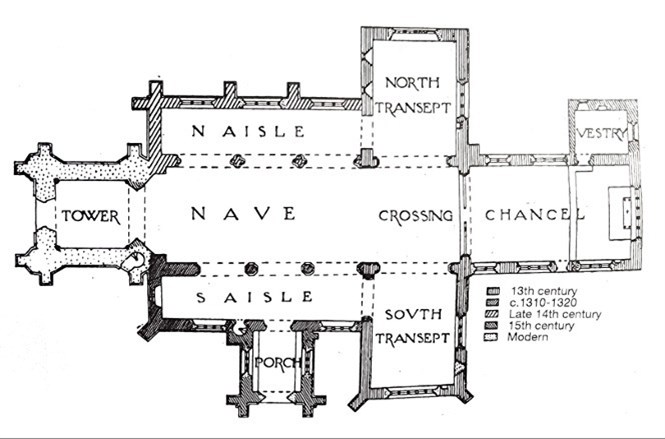 Today you enter the church through the south door, passing through the 15th century porch. The porch is usually decorated in line with the monthly theme and you can also pick up a few useful leaflets about coming events. Over the porch you will notice a priest’s room, or parvise, which in the past probably provided living quarters for a priest and now houses one of the four Bray libraries in Essex, established in the 18th century for the use of the local clergy. The church doorway is 14th century restored.
The church holds approximately 220 people and the large nave is 66 feet long and 22 feet wide. The chancel arch dates from c.1240 and the tower arch at the west end from the 15th century, with graceful slender lines which symbolically lead the eye towards Heaven.
The clerestory is late 15th or early 16th century and was restored in 1858-59. The angel roof is late 15th century with some later oak timbers. The north transept arch dates from 1220-1240 and the pillars of the north arcade are c.1390.The south transept arch is 1220—1240 and the pillars of the south arcade are c.1320.
Today you enter the church through the south door, passing through the 15th century porch. The porch is usually decorated in line with the monthly theme and you can also pick up a few useful leaflets about coming events. Over the porch you will notice a priest’s room, or parvise, which in the past probably provided living quarters for a priest and now houses one of the four Bray libraries in Essex, established in the 18th century for the use of the local clergy. The church doorway is 14th century restored.
The church holds approximately 220 people and the large nave is 66 feet long and 22 feet wide. The chancel arch dates from c.1240 and the tower arch at the west end from the 15th century, with graceful slender lines which symbolically lead the eye towards Heaven.
The clerestory is late 15th or early 16th century and was restored in 1858-59. The angel roof is late 15th century with some later oak timbers. The north transept arch dates from 1220-1240 and the pillars of the north arcade are c.1390.The south transept arch is 1220—1240 and the pillars of the south arcade are c.1320.

 The oak chancel screen is early 15th century as is the oak lectern, which swivels and can be adjusted for height,as seen above, and still retains the chains to which the Bible was once attached. The pulpit is 19th century and was given to the church at a cost of £45. It replaced a three tier pulpit with clerk and reader’s desk which formerly stood at the south end of the screen.
The south aisle was added, or possibly rebuilt, early in the 14th century. The windows in this aisle are 19th century reconstructions, except for the rear arch and splays of the western one. The font has a 13th century bowl, a 15th century oak cover but a Victorian base.
The south transept was built in 1220-1240.The present roof and the east window date from the 15th century. The curved braces of the tie beams rest on roughly carved head corbels on the east wall and moulded corbels on the west. The arch to the south aisle is c.1320.
The oak chancel screen is early 15th century as is the oak lectern, which swivels and can be adjusted for height,as seen above, and still retains the chains to which the Bible was once attached. The pulpit is 19th century and was given to the church at a cost of £45. It replaced a three tier pulpit with clerk and reader’s desk which formerly stood at the south end of the screen.
The south aisle was added, or possibly rebuilt, early in the 14th century. The windows in this aisle are 19th century reconstructions, except for the rear arch and splays of the western one. The font has a 13th century bowl, a 15th century oak cover but a Victorian base.
The south transept was built in 1220-1240.The present roof and the east window date from the 15th century. The curved braces of the tie beams rest on roughly carved head corbels on the east wall and moulded corbels on the west. The arch to the south aisle is c.1320.
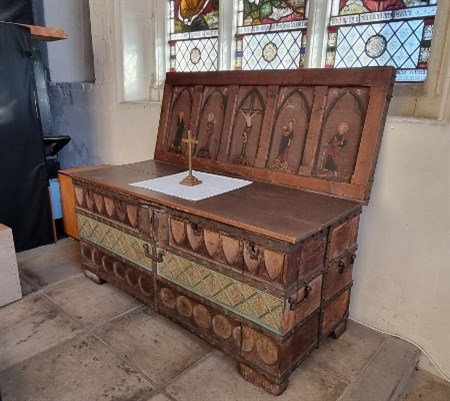 The altar chest in the south transept, known as the Newport Chest, is a portable altar of the late 13th century (700 years old) with space for communion vessels, vestments and missals. The false bottom conceals a secret compartment. The lid is raised to form a reredos and the panel depicts, from left to right, St Peter, the Virgin Mary, the Crucifixion, St John and St Paul, and these are some of the earliest known oil paintings on wood. The altar is made as a chest, with three handles and five locks. The vestments and books would be kept in the locker and the altar stone in the secret place. A fine band of metal tracery ornaments the outside, and the 13th century paintings are on the inside of the lid, which lifted up to form the reredos as we see it today, with its five panels of the Crucifixion. Each saint stands on a mound in a strikingly dramatic pose, delightful representatives of a now old art in its infancy.
The altar chest in the south transept, known as the Newport Chest, is a portable altar of the late 13th century (700 years old) with space for communion vessels, vestments and missals. The false bottom conceals a secret compartment. The lid is raised to form a reredos and the panel depicts, from left to right, St Peter, the Virgin Mary, the Crucifixion, St John and St Paul, and these are some of the earliest known oil paintings on wood. The altar is made as a chest, with three handles and five locks. The vestments and books would be kept in the locker and the altar stone in the secret place. A fine band of metal tracery ornaments the outside, and the 13th century paintings are on the inside of the lid, which lifted up to form the reredos as we see it today, with its five panels of the Crucifixion. Each saint stands on a mound in a strikingly dramatic pose, delightful representatives of a now old art in its infancy.
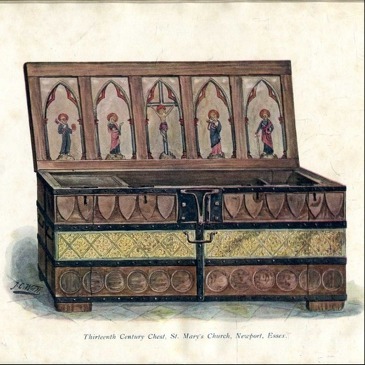
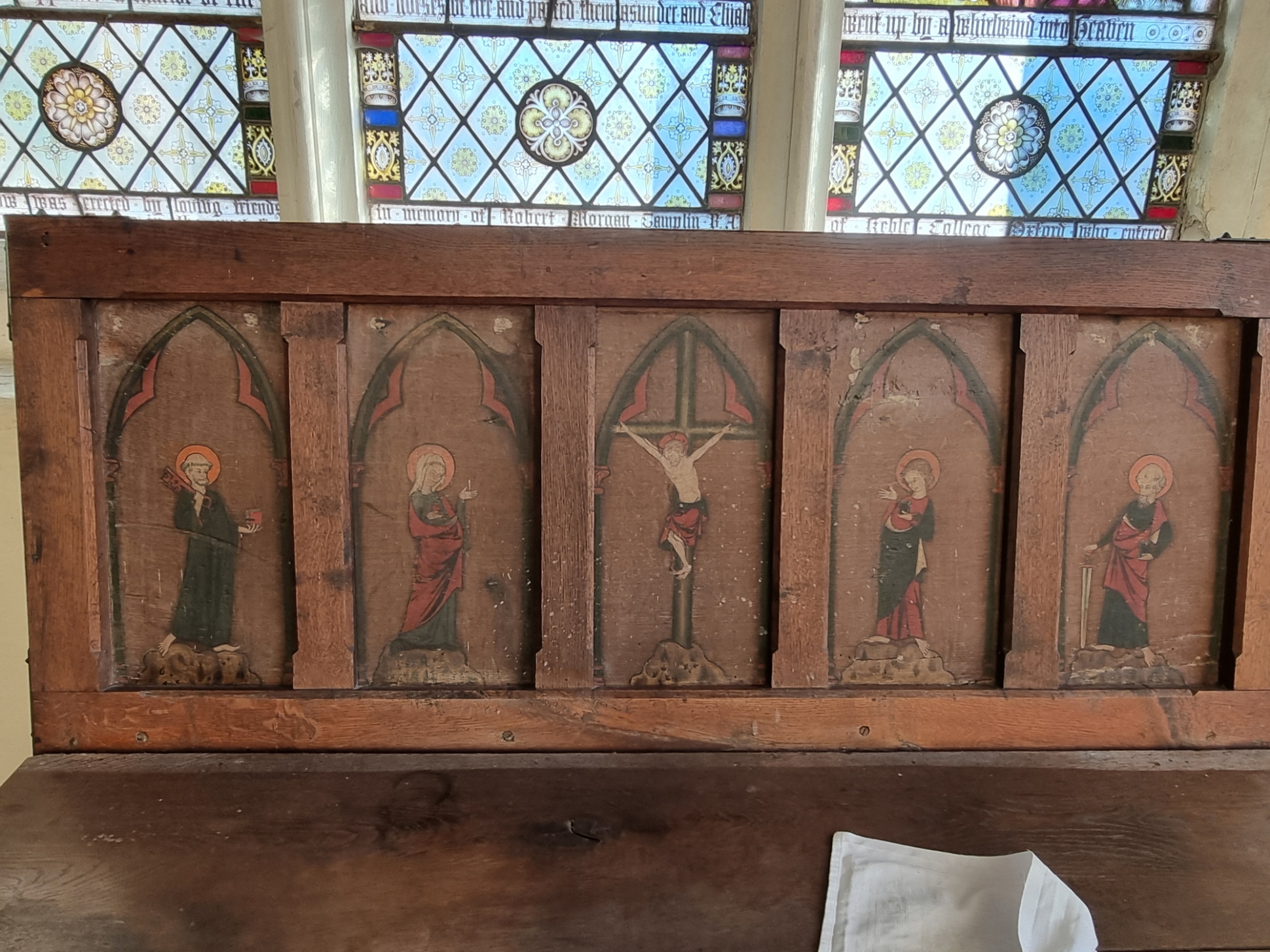 The chancel was completely restored in 1911, but contains much older work. The lower walls date from 1220-1240 and the upper walls were last rebuilt in the 15th century – no mention of the stalls.
The paving throughout the church dates from the major refurbishment of 1858-59, which was made necessary by the fact that the building had deteriorated to a very poor state. The nave roof was restored and the clerestory walls rebuilt, the internal walls were re-plastered and the pillars and the porch restored. Unfortunately during this restoration work many of the ledger stones over the vaults were removed or destroyed, and no record was kept of the actual location of the intra-mural burials in the church.
The tower was completely rebuilt in 1858-59 as the former 15th century tower had been struck by lightning and was dangerously cracked.
Records show the parish was without a priest for much of the 17th century and the church building became neglected. The registers are blank for the period of the Civil War – from 1636 to 1690 there are no records which seem to indicate a similar lack of incumbent over that period.
The chancel was completely restored in 1911, but contains much older work. The lower walls date from 1220-1240 and the upper walls were last rebuilt in the 15th century – no mention of the stalls.
The paving throughout the church dates from the major refurbishment of 1858-59, which was made necessary by the fact that the building had deteriorated to a very poor state. The nave roof was restored and the clerestory walls rebuilt, the internal walls were re-plastered and the pillars and the porch restored. Unfortunately during this restoration work many of the ledger stones over the vaults were removed or destroyed, and no record was kept of the actual location of the intra-mural burials in the church.
The tower was completely rebuilt in 1858-59 as the former 15th century tower had been struck by lightning and was dangerously cracked.
Records show the parish was without a priest for much of the 17th century and the church building became neglected. The registers are blank for the period of the Civil War – from 1636 to 1690 there are no records which seem to indicate a similar lack of incumbent over that period.

A few facts about some of our past vicars
1539: Edward Cowper was formerly the Abbot of Rievaulx in Yorkshire but was dismissed for 'unsuitable behaviour'. He did not support changes made by Henry VIII.
1690: Henry Rix was also headmaster of Newport Free Grammar School, but Edmund Tathum who succeeded him in 1703 reformed the tithe system and instituted a parish rate. Newport had a resident incumbent from then on.
1742: John Lane was shot dead by a highwayman in Epping Forest in 1746. An account states he was believed to be under the influence of drink and made resistance to the robbery.
1748: Richard Knightly, was a younger son of a member of the aristocracy and is described as 'a very odd and out of the way kind of person,' also a 'noisy fox hunting kind of man.'
1779: Brian Hughes was said to be an eccentric vicar who cut off the heads and wings from the angels on the nave roof as he insisted they were idols in God's house.
1794: Thomas Bell had an acrimonious relationship with the people of Newport, he was not on speaking terms with his churchwardens for many years and was sued by the local magistrate.
Fairwell to our pipe organ
![20250212 073542[1]](/Images/content/3188/1385843.jpg)
On the 11th February 2025 the Bardwell organ was removed from the church.
The organ was professionally dismantled by an organ builder and is now in Ireland to be installed in a church there. We are not exactly sure where as yet as a few Churches are interested but once it has been installed we'll get more details along with some pictures. Don't hold your breath though, it could be a good few months (or years) yet! The removal of the pipe organ follows a lengthy faculty application process to replace the pipe organ with a new digital organ kindly gifted by Dr Tim Norris to the Church.
History of music at Newport church
By way of background, Newport Church originally in medieval times had a band of musicians with hurdy gurdies, trombones, sackbuts and such like. Around 1820, Newport Church purchased a barrel organ manufactured by prestigious Walker Organs and with 80 tunes to select amongst; it was located in the South transept of the church. Shortgrove family Butlers bought the church a fine new pipe instrument, also built by Walker Organs, around the year 1876; the barrel organ was converted into a human-playable ("fingered') instrument and moved to Ugley Church where the instrument can be found today and is in good working order.
Around year 1890, the congregation at Newport Church considered that the new Walker organ of year 1876 took too much light from the interior of Newport Church and a decision seems to have been made around year 1910 to move the Walker organ into the West-end tower of Newport Church; this created coordination problems with the organ at the West end and a choir in an East-end chancel region of the church in view of being at opposite ends of the church. By circa 1960, the Walker organ of 1876 was in need of restoration, after circa 80 years of operation.
To save money, George Quintrell had an amateur organ building mate/friend who offered to do the rebuild for a modest sum of money. In 1965, the organ at the West end of Newport Church was dismantled and parts left strewn around the church, then parts of other organs started to accumulate in the church (including an old cinema organ console!). Work dragged on and eventually Rev Reginald Humphries had to call in a solicitor to put a stop to activities of the amateur organ builder. The situation was quite a mess, with a piano being used to accompany services while the pipe organ was out-of-action.
Eventually, the Barnard family (farmers, Newport) gave a donation to Newport Church for rebuilding what was left of the 1876 Walker pipe organ. The sum of money was modest. Rev. Reginald Humphries then selected a cheap-rate organ building firm Robert Slater & Son (who had a questionable reputation in the branch) to rebuild the organ that the aforementioned amateur had managed to wreck. To win the contract, ambitious plans were submitted by Slater & Son including major tonal changes to the organ; however, other parts were skimped with extensive use of chipboard. By 1970, Slater & Son had finished their work, and I remember as a child of circa 11 years of age visiting Newport Church and being impressed at the sound of the organ shortly after its rebuild. However, by that stage, the relationship between George Quintrell and Rev. Reginald Humphries had frayed. Tim's family moved from Widdington to Newport in 1973, and Tim was immediately hired by Rev. Reginald Humphries to replace George Quintrell; it was a challenge for him to take on such a role at such a young age.
Around the year 1972, a leak in the church tower meant that the Slater & Son rebuilt organ was flooded, so as a 13 year old, Tim was confronted by an only partially working organ at Newport Church. Tim remained as organist at Newport Church for 4 years, frustrated by problems with the organ at the West end. Amongst other things, the acoustic sound propagation delay and electro-pneumatic action delay of the organ were very hindering to sensitive fast organ playing. By age 18 Tim was glad to go to university to study.
Since 1977, Newport Church has had several organists (with some marital scandals mixed in to add colour resulting in one of the organists being suspended by Rev. Scott Sanderson!), and during the period 1977 to 2000, the Slater-rebuilt organ became increasingly unreliable.
In around 2008 Newport Church purchased a secondhand Bishop & Son organ from Bardwell Church in Suffolk. Bardwell Church had decided to buy an electronic organ manufactured by Allen Computer Organ Company Inc. The pipe organ was installed in the South transept of Newport Church which shadowed much of the interior of the Church which ironically was the same problem that arose around year 1910.
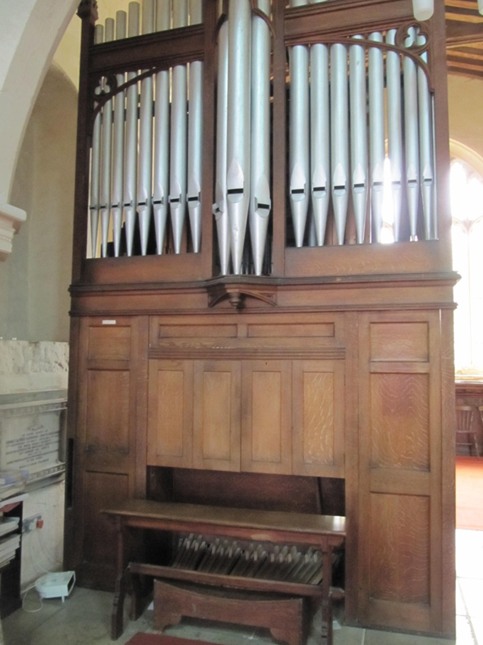
Church services at Newport Church have now become very progressive, with a music band playing two Sundays each month, music streamed regularly over bluetooth and the pipe organ used for one Sunday each month. Ironically, Newport Church has evolved to what was happening in medieval times with a band of musicians, to something akin to a band of musicians in contemporary times.
The objects of the Friend's of St. Mary's Church are to maintain, repair, restore, preserve, improve, beautify and reconstruct for the benefit of the public the fabric of St. Mary's church, it's monuments, fixtures, fittings, furniture, stained glass, ornaments and other chattels and it's churchyard. Responsibility for the building lies with the incumbent, church wardens and the parachial church council, the Friends role is primarily fund raising.
Membership is open to anyone interested in the objects of the Society who has paid annual subscription, which is currently £15 for individuals and £25 for a family.
Please visit their website for more details on fundraising and gifts.
www.friendsofstmarysnewport.org.uk
Chairman: Ben Cowell. Treasurer: Neil Hargreaves. Secretary: Berenice Smith.